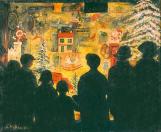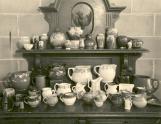2
The Nova Scotia government and handcraftsIn the 1940s the government of Nova Scotia became very interested in promoting the development of handcrafts as an industry. The idea of reviving or inventing handcrafts as a solution to the economic crises of deindustrialization and depression that beset the Maritime provinces after the First World War gained currency in the 1930s and early 1940s. Nova Scotian tourism promoters were especially interested in promoting craft production and followed with great interest the success of the handcrafts industries in Quebec.
In 1943, however, Hagen was also part of a much wider handcrafts movement in the province. As historian Ian McKay comments in his book, "the handicraft revivalists felt obliged to invent...Folklorists [such as Helen Creighton] had much more to work with than handicraft revivalists: they could edit the repertoire of the countryside to produce an official version, whereas the handicrafts revivalists faced a society in which handicrafts were a dwindling resource. If the emergence of folklore was best captured in metaphors of mining [the memories of Nova Scotians], the invention of handicrafts required the language of technical training."1
1 McKay, The Quest of the Folk : 153.
3
Antimodernism in Nova ScotiaIn the late 19th century many Nova Scotians anticipated that the provincial economy would soon be transformed by industrialization - the development of coal mining, railways and factories. By the end of the First World War few held out much hope for an industrial future as factories closed and markets for coal shrank. The Maritime economy was "deindustrializing" and unemployment was widespread. Many Nova Scotians, among them writers and visuals artists, offered a new vision - one in which the "traditional" village life of the province was celebrated and modernity rejected. This idea is known as "antimodernism."
Ian McKay, a historian who has explored this idea argues that :
There was little original about Nova Scotia's twentieth-century craft revival in the international context. What is surprising is how late it was. Elsewhere, the stigma once attached to the handmade products of the home and workshop faded as they attained scarcity value at a time of mass production. From the mid-nineteenth century, Arts and Crafts Movements in England and the United States had held up the ideal of traditional handicrafts as the authentic and pre-industrial antithesis of dehumanized factory labour. Important craft revivals commenced in the rural United states as early as the 1890s. They were as culturally complex as the Antimodernism in which they had their roots.1
1 McKay, The Quest of the Folk : 153.
5
Women and antimodernismWhat we now call "antimodernism" offered employment opportunities for Nova Scotian women as writers, artists and even film producers. However, it must also have produced significant tensions for ambitious women who were working hard to carve out careers for themselves while celebrating a so-called traditional culture which preserved traditional gender roles for men and women. Men usually were depicted by antimodernists as hard-working outdoorsmen braving the elements to harvest the resources of sea and forest. Earning the money to support the family was regarded as the work of the public sphere and belonged to men (at least in the imaginations of the antimodernists. Women, in this view of the world, were expected to stay closer to home, confined to a timeless "private sphere" of babies and cooking. Famed Nova Scotia folklorist Helen Creighton, for example, was an ambitious and hardworking woman who worked tirelessly, with the latest in portable recording equipment, to collect traditional folksongs and stories from rural residents. At the same time, she was struggling to earn an adequate income to support herself and to achieve professional credibility in the male-dominated field of folklore in the academy.
Provincial craft promoter Mary Black (1895-1988) found herself in a similar situation. In 1943, Black had been appointed as Supervisor of Handcrafts in the Department of Industry and Publicity to promote the development of crafts. Born in Massachusetts and raised in Nova Scotia, she worked from 1922 to 1939 as an occupational therapist in a number of hospitals in the United States. In the late 1930s she visited Sweden, at the forefront of the craft revival, to study weaving techniques. (1) In 1944 Black developed a plan which would use the development of handcrafts skills to improve living standards, provide employment for wounded veterans and assist remote and underdeveloped parts of the province. (2)
In The Quest of the Folk, historian Ian McKay has argued that Mary Black was not an antimodernist, although her work contributed to antimodernist ideas in Nova Scotia, but a liberal progressive professional, guided by ideals of efficiency, competitiveness, moral therapy and commerce. In her vision, handcrafts were not in any sense to be seen as havens in a heartless commercial world. They were to be fully integrated into the market, and those that were not viable on those terms had no claims on public sympathy or support. (3)
The same can be argued for Alice Hagen. Her concern with pottery as occupational therapy especially well suited to the disabled is a modern social work concern that was no doubt rooted as much in her Catholicism, especially her work with the Catholic Women's Leagues, as in the Arts and Crafts revival.
In the early 20th century women who actively pursued education and meaningful careers were often referred to as "New Women". Helen Creighton, Mary Black and Alice Hagen all fit this description, and all three made significant contributions to the cultural life of their native province. The tensions between the traditional ideas about gender roles inherent in antimodernism and the ambitions of women who were attempting to expand their educational, professional and economic opportunities must have been fruitful because so many of them rose to prominence in the cultural field during this period.
(1) McKay, The Quest of the Folk: 165-66.
(2) McKay, The Quest of the Folk: 172.
(3) McKay, The Quest of the Folk: 179.
7
Early recognition of Alice Hagen as a potterIn 1944, the "Canadian Geographical Journal" published an article on pottery in Canada. Its author, Ruth Home, claimed:
"Pottery in Nova Scotia means Alice Hagen. There are no professional potters in the province but the Department of Education has since 1938 sponsored a summer course for the training of teachers under Mrs. A. Hagen. The course covers a period of three four-week summer courses and leads to a diploma. Mrs. Hagen works in close co-operation with the Nova Scotia College of Art. Local clays are used entirely for the bodies, good clay being found all along the Annapolis Valley from Shubenacadie to Antigonish. The glazes have, until recently, been imported from England, but in 1941-42 they made their own translucent and opaque white." (1)
(1) Ruth M. Home, "Pottery in Canada", Canadian Geographical Journal (February 1944) : 75.


